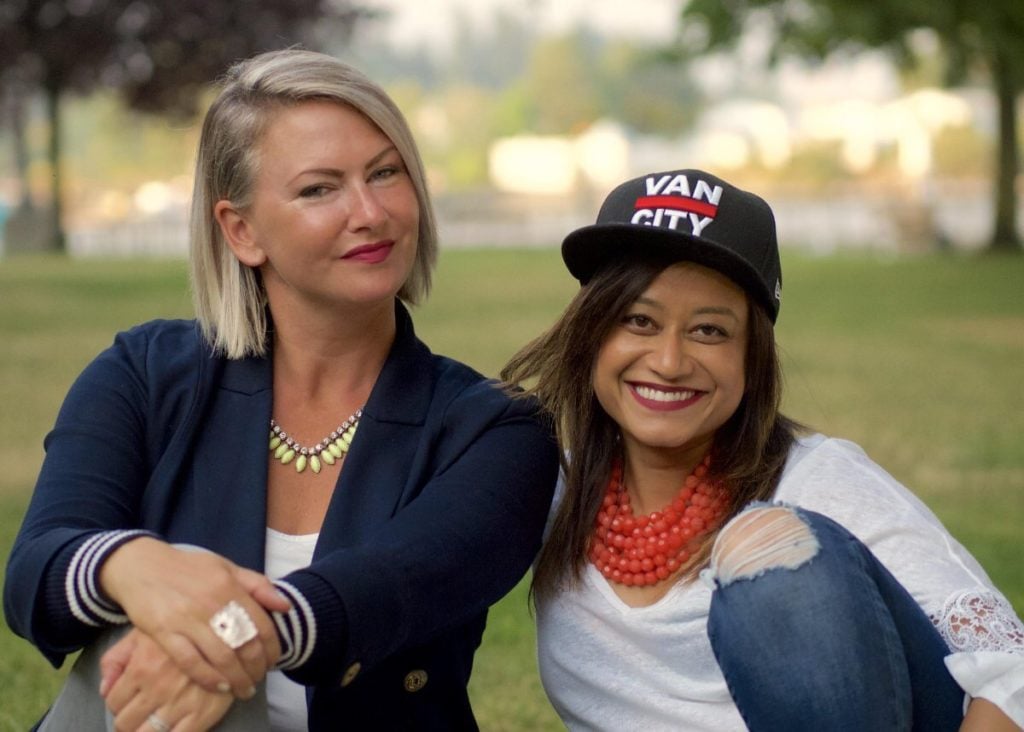 Smita (R) pictured with her friend and business partner, Andrea Bell.
Smita (R) pictured with her friend and business partner, Andrea Bell.
You graduated in 1999. In terms of further studies, where did you go after York House?
After graduating, I went across the pond to Dublin, Ireland. I was there for seven years completing my medical degrees and internship training. It was an incredible time to be there as Ireland had just switched to the Euro currency as a member of the EU. A true snapshot for me of living through political and historical change.
Describe a typical working day at BC Children’s Hospital?
That’s a tough one, because there is no “typical” day. This is what drives me to working in the emergency department. I start my day checking in on the admitted patients with our entire team. We problem shoot, review medication and treatment. Most importantly, we make sure the families of the children admitted are consistently involved in the “loop of communication.” That is the only hour in my day, set in stone. The rest is dependent on who presents to the Emergency Department. We get paged across the Province and the Yukon by family doctors and paediatricians asking us for educational support on ethical or high risk situations.
You kindly came back to York House to speak to our students during Career Day a few years ago. What was that experience like?
I was so nervous! The hardest thing to do, is to inspire a group of intelligent and driven young women despite their personal experiences, cultural background, and passions. For me, speaking in front of adults, and other clinicians is the easier part of my work. Being able to look an an audience, and see why they took their time to listen to me, is definitely an art I am continuously working on. There is nothing more that matters to me then the mental health, and overall wellness of our youth. One thing that is on my bucket list, is to craft and deliver a speech to the graduates. Even better, maybe address the year one of my Yorkie nieces graduates (2025!).
Your new publication for kids is about the importance of sleep. How did this collaboration come about and tell us more about Polly & Pickles?
Believe it or not, I met my business partner, now dear friend Andrea Bell, on a plane ride from LAX to YVR 30,000 feet above ground! We instantly matched and had a shared vision of creating children’s books with a meaning.

Within less than three months, Paper Clouds Project Ltd was born. We self-published our first book on sleep, which was just released this January 2018. We chose sleep as our first book because clinically this is the simplest way of altering the behaviour of a child and the environment of a home. Andrea was personally adjusting to having three children of different developmental ages and found that in the working-mom world, the value of sleep is under prioritized.
Did anyone or any one experience inspire you at YHS to follow your dreams of being a psychiatrist and author?
Yes. Absolutely. Mr. B! It’s amazing the impact a few comments, experiences can influence us to the core, to our gene expression. Mr. B was like a father to me, when he was training us for track meets, and inspiring us to do more. I still remember when he was discussing muscle physiology and used me as an example. It touched me, because that authentic validation in front of my peers, truly set further ground work to a healthy self-esteem. Alongside my parents, and two older brothers, Mr. B certainly made me feel I had gifts to share with the world.
For members of our community with young children, provide three tips on how to get our kids to sleep smarter/better?
I have one word for you R.E.D.!
- Routine! If you can make one change, create a cheat sheet for sleep with your child. Make two copies, one in the washroom, one in the bedroom. From the moment your child/youth enters home after a busy day at YHS, their routine begins! The misnomer is that if you have a “good bedtime routine” things should work out. Not true! Transitioning from a structured environment (i.e. school) to a semi/non-structured environment, sends signals to their brains making it more scattered, unsure, and even anxious. Ground a few things: homework time, dinner time, fun/social media time. This is the most beneficial and most sustainable gift you can give your child. This level of routine, trains your body clock (i.e. circadian rhythm) on when to release melatonin and other hormones promoting good sleep and brain growth.
- Environment: Make sure the child’s bedroom does NOT have a desk for study. Associating a child’s room with anything but calm, is never a good idea. A desk, if used for study, then sub-consciously associates the room of stress, deadlines and at times, poorer self esteem. Keep it minimalistic, filled with meaningful objects for your child (not your own aesthetic pleasure). By doing this, you are giving your child the autonomy to create their sanctuary with some guidance. Due to limited space, busier lifestyles, our rooms are now multi-purpose. This is one room, you want (for the entire family) to only serve for one purpose alone…sleep/relaxation.
- Distraction Devices: aka iPads/mobile phones! There may be many changes with technology, but one thing which has stayed consistent over the years, are the guidelines of screen time. No screen time two hours before bedtime for the entire family. The way to avoid the “power struggle”, ALL family members, give up their devices with the EARLIEST bedtime in the home. This then creates a uniform expectation and the child/youth no longer views this as a punishment or that they are “missing out” on something.

